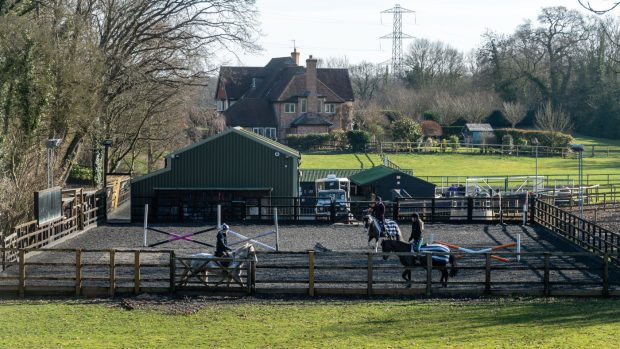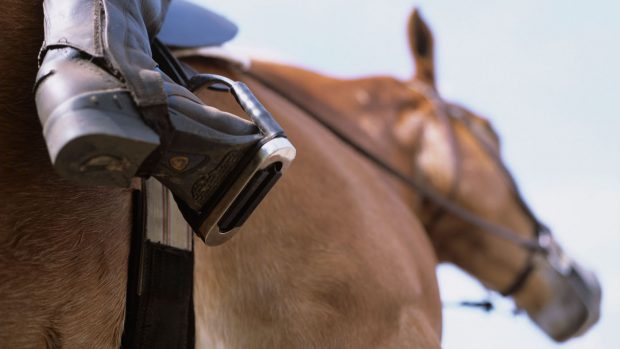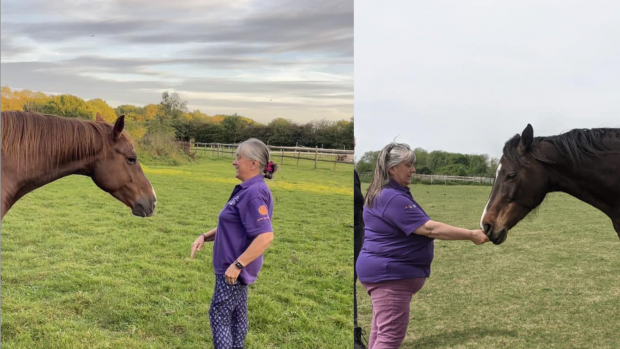A showing rider has shed eight stone after deciding to have gastric bypass surgery for the welfare of her horse.
Amanda Firman, 51, from Hartfield in Sussex, was concerned she was too heavy for her show hunter Ted and was also desperate to lose weight for the sake of her own health.
Just two days after competing in the SEIB Search for a Star final at Horse of the Year Show (HOYS) in 2015, she went in for the operation at Spire Gatwick Park Hospital in Horley, Surrey.

Amanda Firman competing before she had surgery. Credit D Barta.
She opted for a bypass procedure that reduces the size of the stomach and reroutes the intestine. It is thought the bypass gives a better chance of sustained weight loss than gastric bands.
In the two years since the surgery, Amanda has dropped five dress sizes to a 10-12 and is now aiming to qualify for HOYS again in 2018.
“When I took part last time I weighed 20 stone, which I didn’t feel was good for my horse’s back,” she said. “I even had to have my riding jacket made specially as I was a size 22.”

Amanda after surgery
Aside from feeling awkward in the saddle, Amanda’s weight caused her a range of issues and she often found herself tired and in pain. She developed arthritis in her knees and ankles and would take up to two hours to muck out a stable.
While she knew her size was to blame, she found dieting a struggle.
“I was taking pain killers five times a day and having steroid injections – it was like self-inflicted pain because my weight was causing it,” she said.
“I kept trying to diet but gave up. There were too many temptations in the way and I had no will power, so I would put the weight back on again.”
Amanda’s weight gain had been sparked 10 years earlier when she was diagnosed with myalgic encephalomyelitis (ME).
The debilitating condition led her to seek out high-sugar foods to try and source some energy.
“People don’t realise what a debilitating condition it is. I struggled to put one foot in front of the other and used to cry in the shower just because I was so tired,” she explained.
“I ate the wrong things — chocolate, fizzy pop, cakes, biscuits — anything sweet that would give me a kick for a while. Eating became a problem and the more tired I became the more I needed an energy boost to get me through the next hour or so.”

Amanda Firman after surgery with her husband Colin
Amanda found herself stuck in a vicious circle, eating more and becoming increasingly inactive. She reduced her working hours to part-time in order to cope and could only ride her horse for a few minutes at a time before exhaustion kicked in.
“I kept trying to diet but my fatigue always got the better of me, so for my health and the health of my horse — I was always worried I was too heavy for him — I decided to have surgery,” she said.
Before she could have the operation, her bariatric surgeon Mr Simon Monkhouse put her on a strict 800 calorie-a-day diet for two weeks. The pre-op weight loss is designed to reduce fat around the liver and make surgery safer.
Two days after surgery, Amanda was discharged from hospital. She was back to work the following week and was riding a few weeks later.
Her weight reduced quickly as the bypass meant she could only eat very small portions at a time, gradually building to a tea-plate sized meal for dinner.
She also has to take daily supplements because her body now absorbs fewer vitamins and minerals and has to be careful not to eat rich food which can lead to nausea.
“I can still eat anything I like, but much smaller portions and now what I eat is more valuable. I make sure it is the right thing, but I am not a total saint and will have a piece of chocolate or a biscuit, and occasionally love a duck wrap,” she said.

Amanda in her new side saddle habit
By June last year, nine months after the operation, Amanda had shed eight stone and found the pain in her joints had disappeared.
She bought a new house with stables and land with her husband Colin and also treated herself to a new horse — a handsome hunter called Johnnie The Fox, who she hopes to begin competing in HOYS qualifiers in 2018.
While Amanda still suffers with ME, the tiredness is no longer aggravated by joint pain and excess weight. She is up at 5am to head to the stables, and can ride up to 40 minutes at a time.
“I have had to learn to ride slim,” she said. “Before, I was so fat, I just sat there. And now, not having pain in my ankles and knees, has made a huge difference. I have the determination to do more.”
Her surgeon Mr Monkhouse said: “Weight loss surgery is not going to make a dent in the obesity levels of the nation, but it does make a massive difference to individuals like Amanda. It can change their lives forever in a positive way, and put certain health conditions such as arthritis and diabetes into remission.”
For all the latest news analysis, competition reports, interviews, features and much more, don’t miss Horse & Hound magazine, on sale every Thursday





